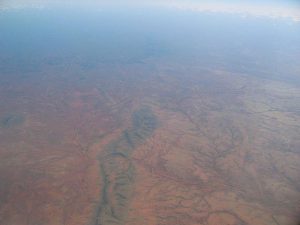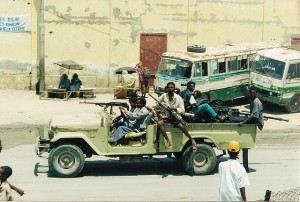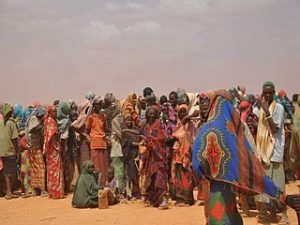Pirates, scientists and climate change
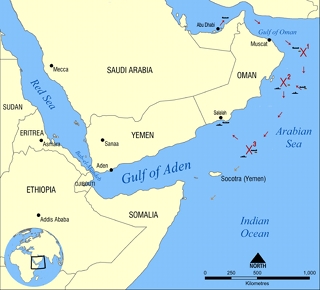 “It was like the wild west out there”. This comment was not made by a soldier after fighting in the streets of Bagdad, or by a police officer coming back from a difficult raid in a dangerous favela in Rio. No, it was made by Peter deMenocal, a marine geologist of Columbia university, quoted in an article recently published in The Atlantic (Schiffman, 16 Oct 2013). The article describes how a science vessel braved Somali pirates to extract sediments from the seabed of the Indian ocean.
“It was like the wild west out there”. This comment was not made by a soldier after fighting in the streets of Bagdad, or by a police officer coming back from a difficult raid in a dangerous favela in Rio. No, it was made by Peter deMenocal, a marine geologist of Columbia university, quoted in an article recently published in The Atlantic (Schiffman, 16 Oct 2013). The article describes how a science vessel braved Somali pirates to extract sediments from the seabed of the Indian ocean.
Those sediments were used to study the way Eastern Sahara and the Horn of Africa became a desert. The results show that the transformation of what was once a wet and green area into an arid desert was not the result of a gradual process, but, in fact, a very quick transformation, that took one or two hundred years. The former theory was supporting the hypothesis that the process had lasted thousand years. One hundred years, on the contrary, represents only three or four human generations, with grand parents able to explain the changes to their children’s children. The dynamics that were involved were as followed: the less it rained, the more vegetation died, the more the topsoil lost its humidity, absorbing more and more heat, and so accelerating further the decline of vegetation, while disturbing rain and weather patterns, which favoured the emergence of aridity, in a series of interlocked feedback loops.
Thus, it shows that climate and weather patterns, and thus, life conditions for vegetal, animal and human species, do not evolve gradually, but are sensitive to different kinds of forcing. This new perspective on desertification pushed a Columbia university’s scientist to ask the US Navy to protect a new scientific expedition in the Indian Ocean. But this demand was not accepted… (Schiffman, ibid.).
The “Pirates lake”
The Gulf of Aden is one of the most important maritime routes on earth and home to two crucial chokepoints, because it links the Red Sea, as well as, through Suez, the Mediterranean Sea, and through Bab-el-Mandeb, the Arabian sea, to the Indian Ocean. And it is rife with Somali pirates. Those pirates attack all kinds of ships, stop them, take the crews as hostages, and know how to exact very significant ransoms from governments and private shipping companies. For example, at the peak of pirates attacks, more than 58 millions dollars were exacted through ransoms in 2009 and 238 millions dollars in 2010 (Oceans beyond Piracy, The Economic Cost of Piracy). Yet, the total cost must not only include ransoms, but also insurance, re-routing, deterrent security equipment of naval forces, of pirate prosecution, of piracy deterrent organizations. Finally, one must also add macro-economic cost, such as cost to regional trade, food price inflation, and reduced foreign revenue (ibid).
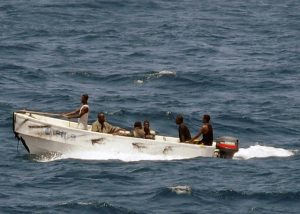
Starting with the beginning of the 21st century (Parenti, Tropic of Chaos, 2011), Somali piracy home-made, small-scale tradecraft, is a tentative reconversion of a few (very) poor Somali fishermen. It quickly became an industrial activity, generating tens to hundreds of millions of dollars a year, carried out by pirate fleets better equipped and armed through the years, and going farther and farther away in the Indian ocean (Valin, EchoGeo, 2009). They turned a whole swathe of the Indian Ocean into a “pirates lake”, leading major actors such as the members of the insurance market, Lloyd’s, to raise insurance premiums, thus costing five to six billions dollars a year to global trade.
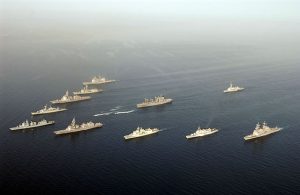
European, US, Russian and Asian governments have had to divert some of their Navies in the region, integrating their naval forces, for example through the “combined task to force 150”, composed of EU, NATO, US, Japanese, Russian, Indian and Chinese vessels, to fight back at the pirates.
Isn’t it strange to think that some of the poorest people of our world, inhabiting a devastated and highly peripheral country, have become such a powerful force in the shaping of maritime traffic, which is nothing else but the very core of globalization?
Somalia, a case study in collapse
During the seventies and the eighties, Somalia, ruled by Siad Barre and his proxies, started a game of shifting alliances between the U.S.S.R. and the United States, in order to conquer the Ogaden region from its socialist ally and neighbour, Ethiopia (Smith, Négrologie, 2003). The war ended as a massive military, political and financial failure for the Barre regime. A series of drought, coupled with economic stresses driven by the fiscal demands of the failing state, destroyed the fragile agricultural and pastoral economy of the country (Parenti, Ibid). Barre fled in 1991, while the country was sinking into civil war, agricultural desolation, armed and dangerous factionalism (Bowden, Dirty Wars, 2013).
Now, Somali people are either being subjected everyday of their (rather short) existence to the brutality of the life with militias or having to become militiamen, while enduring a harsh and unforgiving environment, dominated by an arid climate, progressively worsened by global warming. For example, the structural lack of rainwater makes it difficult to drink, to eat, to be healthy (in 2009-2010, a new famine was triggered by the failure of yearly precipitations, and between 2010 and 2012, an estimated 258,000 excess deaths was attributable to severe food insecurity and famine in southern and central Somalia – see 2013 FAO FEWSNET report). Furthermore, as military sociology has exposed over the last forty years, the more and longer people and combatants are being brutalized by battle and war conditions the more brutal they become (Bartov, Hitler’s Army, 1992).
If state failure, social disintegration and heightened climate pressure on a vulnerable agricultural and pastoral society made Somalia a place of thriving violence and misery (Parenti, Ibid.), it furthermore opened a huge corridor of lawlessness off its coast. Somalia has indeed a very large stretch of coastline, 3330 km long. Thus, since the beginning of the new phase of the civil war, starting shortly after 2001-2002, the affirmation of three uneasy and fragile regional zones and the short-lived but very violent “islamic courts”, which destroyed many warlords before their disintegration (and transformation into Islamic Al-Shaabab militias), the exclusive economic zone of Somalia has been systematically pillaged by fishing fleets from numerous countries, composed of massive high sea trawlers, often under pavilion of convenience (Tharoor, Time World, 18 April 2009). Reports establish that, each year, more than three hundred millions dollars worth of seafood are fished and taken from under-equipped Somali fishermen (e.g. Dagne, CRS Report: Somalia, CFR, March 12, 2007). Other reports show that, in the meantime, numerous ships have illegally shed toxic industrial wastes, even radioactive wastes, from Europe (some of these shipments certainly being organised by Napolitano mafia), off Somali coastline (Ould-Abdallah, UN envoy, 2008). A UN environment program report (2005, 2007) establishes that dumping these residues off Somali coastline costs 2.50 dollars, against 250 dollars for a clean destruction in Europe. The “success” of the Somalian sea region came also from the overfishing of other parts of the Indian Ocean and of the Mediterranean Sea. The depletion of fish stocks in other parts of the world oceans made for a stark contrast with the life thriving sea of the Gulf of Aden and Arabian Sea region, because of the small indigenous fishing operations, which had a preservation effect on the biological resource. This led to an epidemic of chronic illness among the littoral Somalian population, from skin to respiratory ailments, while these communities where losing their source of food and finance. Meanwhile they were subjected to a series of long heat waves, droughts and disorganized monsoons, as the impact of climate change is increasingly stronger in the region (UNEP report, 2005; Britain weather service). Fishermen had nowhere to go and no choice, their hinterland being ravaged by the new coalitions at war, notably the new Islamist militias named Al Shaabab (Bahadur, 2012). The sea being their only available resource and the only world they knew, all their wealth being tied to the sea, as fishing and cargo boats, if fishing could no longer be an available resource, then fishermen moved into the piracy business, only changing the purpose of vessels and crews. Pirates quickly became very efficient at taking ship crews as hostages and at exacting ransoms from private shipping companies and governments. This new activity gives a very special geopolitical status to Somali pirates because their presence in the Gulf of Aden and the Arabian Sea is a very severe threat in one of the main maritime corridors, through which pass most of the oil tankers and trade ships from the Mediterranean Sea and the Arabian Sea to the Indian Ocean. In other words, they are a threat not only to international trade, but also to international energy lines, hence the important military international reaction. The number of incidents between military vessels and pirates, added to an important use of private security professionals by shipping companies, seems to have had an effect in deflecting a growing number of attacks (237 attacks in 2011, 75 in 2012 – International Chamber of Commerce, 16 January 2013), while numerous Somali crews were arrested. However, pirates are also going deeper and deeper in the Indian Ocean. The decrease in number of attacks is not only caused by international and private reactions and repression, but also by a new metamorphosis of piracy, with many pirate operations selling their services for the “protection” of ships crossing the Gulf of Aden and part of the Arabian Sea. Another evolution is that, if the number of attacks and successful hijacking are decreasing, these operations have become very organised and some specialists expect more violent attacks or hijack high-profile targets, as oil tankers, as well as new tactics, involving several ships with better armed crews (Bahadur interview on CBC, 23 June 2013). As Edward Luttwak neatly points out, the logic of strategy is of a paradoxical nature (Luttwak, 1987). Every action reverses in its opposite, largely because of the reactions and the unintended consequences it triggers, and because of its inner effects on those who implement it. If the causes of piracy are civil war, climate, overfishing and criminal pollution, piracy also has numerous feedback effects on these different areas. Numerous researchers in maritime biology establish that, by making trawlers avoiding the Somali off coast region, marine life is recovering, helping fishermen to better their catches and having very beneficial effects for the food and financial security of the coastal communities (Jill Craig, 2 August 2012, Voice of America). However, at the same time, the financial success of pirates has attracted the attention of militias, among which the Islamist militia Al Shaabab, which started to racket the pirates in order to insure a steady cash flow for their own agenda, linked to Al-Qaeda, especially in Yemen (Parenti, 2011, ibid.), on the other side of the Gulf of Aden. It should be noted that, even if piracy is an inherently dangerous activity, becoming increasingly more lethal because of the logistics of small boats at sea and because of the international military cooperation and growing use of private security, which translates into numerous naval battles, sinking, drowning and arrests, there is a never-ending flow of volunteers for piracy from the hinterland. This situation comes as no surprise, given that mass hunger is back in Somalia since the dire droughts in 2010 and 2011, which Britain weather service, after having surveyed the weather patterns of the whole region, explicitly link to global warming. If Kenya and Ethiopia could benefit of international food relief, it was not the case for Somalia, because of the security situation for numerous NGOs. Thus, Somali pirates “exchange” their political and environmental crisis for an activity that means a security crisis for the world shipping and energy industries. Thus, Somali pirates “exchange” their political and environmental crisis for an activity that means a security crisis for the world shipping and energy industries. Their success attracts numerous young volunteers, all the more so since the return of extreme drought since 2010 as seen, who have been subjected to a pitiless process of “brutalization” by social, political, economic, national and international forces, while the planetary ecological global change is aggravating the overall dynamic. Decades of civil war, combined with disastrously long drought, which bring very poor harvests and worsen human and animal access to water, have made of Somalia one of the toughest and hardest place on earth to survive. Somali pirates have thus become hard-as-stone survivors, immersed in a warrior culture, projected on the Gulf of Aden, the Arabian Sea and the Indian Ocean, in a region destabilized by war, climate change and competition for marine resources. Given the fact that the set of social, political and environmental conditions from which has emerged Somali is not only still active, but worsens and impacts the whole region of the horn of Africa and of the Red Sea, one can only expect to see this violent social process spread to the whole region, potentially adopting new forms, ways and means, with similar numerous regional, international and global economic and strategic effects. The emergence and development of Somali piracy is not an “exotic” and aberrant appendix to globalization. Instead, it reveals the complex intricacies between contemporary social, economic and planetary dynamics. The way fishing industry overexploited the Arabian Sea and Somali Exclusive Exploitation Zone and the way those areas have been used by industries and the Italian mafia as dumping site for toxic wastes is symptomatic of the trends that threaten marine life and sea water quality currently, on a global scale. Furthermore, these two ways to use – and abuse – the sea combine themselves into a looming world health problem, sea food having become a vector of bio-concentration of chemical pollution, which is absorbed by consumers on a global scale (Roberts, The Ocean of Life, 2012). This overexploitation obliged Somali fishermen, under the pressure of further and non-viable impoverishment, to become pirates. The political, food and climate situation of the country, awash with weapons, changed piracy into the equivalent of an economic boom, a quasi industrial revolution but in the sector of violent services, feeding on maritime globalization, illegal overfishing and pollution, under a harsh and changing climate. In other words, Somalian piracy is a perfect example of the way a human society reacts and adapts itself to the strange and retroactive mix of environmental pressure (in this case, climate change and the overexploitation of seafood added to waste dumping by non Somali actors), social and political collapse and war. This situation is typical of what a growing number of geophysicists and biologists define as “the Anthropocene”, this new geological and biological era where the human species has become the principal source of pressure on the planetary environment, and where multiple feedbacks emerge from planetary environment and put societies under new kind of pressures. As the Royal society sums it up: “Anthropogenic changes to the Earth’s climate, land, oceans and biosphere are now so great and so rapid that the concept of a new geological epoch defined by the action of humans, the Anthropocene, is widely and seriously debated.” (Zalasiewicz, Royal Society, 2011). Hence, piracy is a quite successful adaptive response of coastal Somali communities to the local and regional manifestations of this new condition of humanity on this planet, defined by James Howard Kunstler in 2005 as “the long emergency”. Is it possible to influence this new social-planetary trend? Or shall we be condemned to only adapt ourselves to a permanently changing global situation, with multiple and dire impacts in very diverse areas? The terrible effects of these trends on the Horn of Africa lead us to wonder what is going to happen in other areas similarly impacted by these new sets of feedback loops, such as Central America, the Arctic… and a lot of major coastal cities around the world.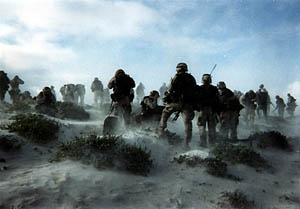 This toughness was experienced in Mogadishu in 1993, by the U.S. Special Forces, Rangers and Delta Forces, in their vain tentative to catch the famous warlord Mohamed Farrah Aïdid. Mark Bowden, author of the “Lawless sea, piracy and environmental collapse
This toughness was experienced in Mogadishu in 1993, by the U.S. Special Forces, Rangers and Delta Forces, in their vain tentative to catch the famous warlord Mohamed Farrah Aïdid. Mark Bowden, author of the “Lawless sea, piracy and environmental collapse
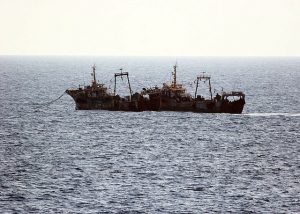
Pirates as “eco-warriors” ?
Piracy, a metaphor for tomorrow’s life on a new and dangerous planet?


